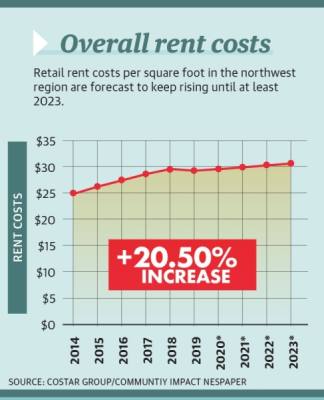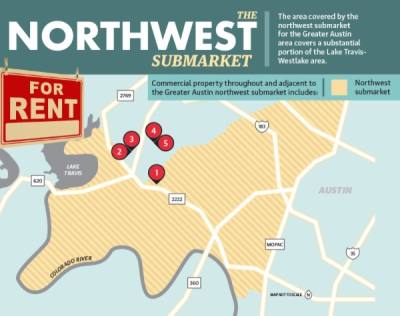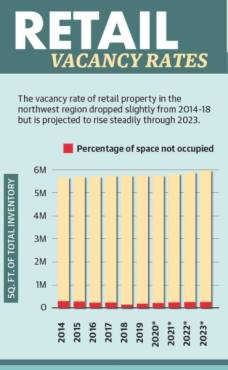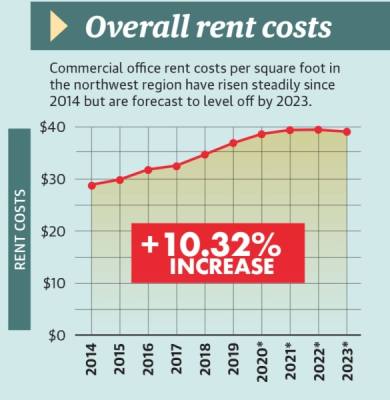It was a move that created a seismic uptick in the vacancy rate of an entire commercial submarket in the Greater Austin area: In 2017, 3M Co. sold its 1.3 million-square-foot center in the Four Points area to real estate investment firm World Class Capital Group.
It was just one building in the northwest commercial submarket of the Greater Austin area, but on paper that closing created a more than six-point swing in the area’s office property vacancy rate, bringing it from 9.58% in 2018 to 15.96% in 2019. Projections through 2023 show the vacancy rate for the northwest submarket dropping slightly through 2023, but not coming close dipping below 10% any time soon.
Sam Tenenbaum, director of analytics for the CoStar Group, a commercial real estate data company that provided that data, said because it was just one building, that upswing can be deceiving.
“You could make a convincing argument that that the roughly 1.2 [million] or 1.3 million square feet that building represents is just one building, so you could exclude it [from the data], but the problem with that is if you exclude it today, you have to exclude it back over history, so it really kind of messes with the stats,” Tenenbaum said.
But some commercial real estate developers and brokers operating in the northwest submarket maintain there are many aspects of the area that make commercial land acquisition and development difficult, underscoring why the vacancy of one big building could create such a significant data jump.
The value of the land
According to area commercial property owners, the northwest Travis County area has many attractive facets to lure potential investors. It is geographically dynamic, with several trail systems and nature preserves, and compared with areas such as downtown Austin, land is much more affordable.
But those aspects can also present difficulties for developers and owners, according to Joe Simmons, senior vice president of Aquila, a commercial real estate firm active in the Austin area.
Simmons said a number of factors contribute to difficulties purchasing land in the northwest submarket of the Austin area, especially along RM 620 between Hwy. 71 and US 183, as well as other arteries near RM 620, including RM 2222.
For one thing, there are some fairly restrictive watersheds running along the area, including the Bull Creek Watershed and the Lake Travis Watershed, Simmons said.
“Pursuant to those watersheds, the amount of impervious cover you can put on properties in that area, which means the amount of hardscape and the amount of building you can put on a site, is fairly restrictive,” he said. “That makes it difficult to do tremendously dense projects because you have to purchase enough land so that you can have the appropriate ratio of pervious to impervious cover.”
Coupled with strict impervious cover restrictions caused by the area’s geography, other environmental issues come into play, especially along RM 620, according to Simmons, who said the fact no land can be developed in the Balcones Canyonland Preserve, which occupies a substantial swath of western Travis County, makes available land even more attractive for commercial developers.
Simmons, who also works with PacVentures Inc., a commercial real estate investment firm based in California, said he helped broker a recent deal to convert a former Walmart store on RM 620 into an office property called the Preserve at 620.
Due to all of the hurdles in place pertaining to establishing profitable commercial property in the northwest submarket, Simmons said the conversion of the former Walmart into the Preserve at 620 was a fortuitous scenario.
“As far as restrictions dealing with the watershed, it means you have to purchase a certain amount of tract to get a certain amount of square footage,” he said. “And what was attractive about Walmart was all the permitting and building was already there, so we didn’t have to go through all of that headache. There are very few, if any, large tracts that enable you to have a large square footage project, at least not anymore.”
Those restrictions can also contribute to increased land valuations, according to Simmons, who said while land in the northwest submarket is not nearly as expensive as commercial property in the downtown Austin area, the fact that much less square footage can be placed on the land due to impervious cover restrictions means much more land has to be purchased.
Factors affecting valuation
Jim “Jimbo” Cotton is a real estate broker and developer in the Austin area. Cotton said he helped broker the deal that brought the H-E-B to Lakeway on RM 620, and he has also been a key player in deals in the Lakeline area in Northwest Austin.
Cotton said right now he owns about 45 commercial properties throughout Austin, and the northwest submarket, at least from his perspective, is a healthy one for developers. One property he does not own but mentioned as an example is the Center at Four Points, which is under construction and should have a substantial percentage of its tenants moved in by summer.
“One of the reasons that area is so strong is because of the restraints on development,” Cotton said, echoing Simmons’ point that the land along and around the central and northern segments of RM 620 is essentially more valuable because of the impervious cover limits. “Every square inch out there would have [development] on it if you could get more development rights. The usable land is so much more valuable.”
Travis Central Appraisal District is the main entity that assesses property valuation throughout Travis County, and Chief Appraiser Marya Crigler said the primary method for determining value for commercial properties is what is known as an income approach, which examines what an investor would purchase the property for based on the income it could generate.
Crigler said the more dense areas of the northwest submarket come with considerations for valuation that differ from those of the less dense areas, such as north of Lakeway.
Rent growth and vacancy rates
Information gathered from CoStar Group shows retail vacancy rates in the northwest region steadily increasing from 3% in 2019 to 4.3% in 2023. The same is basically true of commercial office property with the aforementioned exception of the 3M Co. facility.
Beyond that giant leap in 2019, vacancy rates for retail and office properties are expected to rise slightly from 2020-23, and this is partly because of a predicted economic downturn that Tenenbaum said is factored into CoStar’s data projections.
“That will happen as we run out of people to hire,” Tenenbaum said. “The unemployment rate in Austin is incredibly low right now. With a slowdown in job growth, that also means a slowdown in the real estate markets across Austin generally. That obviously affects us in Northwest Austin as well, so that’s why we might see that vacancy rate edge up a little bit over the next couple of years.”
Another data set forecast to hold relatively stable in the coming years is rent growth, which is defined by the percentage average asking commercial rent prices grow year over year.
In the commercial retail properties of the northwest region, rent growth dropped one percentage point from 5.1% in 2014 to 4.1% in 2018. Though it showed a more sizable drop in 2019, falling all the way to -1.1%, growth is expected to rise slightly and top out at 1.2% by 2023.
“The rent growth is still positive, which is good, I suppose, if you’re a landlord, but not necessarily if you’re a tenant,” Tenenbaum said.
Impervious cover restrictions
Cotton said another factor that makes the northwest submarket disadvantageous for tenants is the fact that actual square footage able to be built on land in the area encompasses such a small percentage of the total acreage.
Matt Hollon, division manager of planning in Austin’s Watershed Protection Department, said projects containing more than 5,000 square feet have different impervious cover restrictions depending on their zoning and require developers to acquire permits from the city and provide water-quality controls.
There are several watersheds in the Northwest Austin area that demand more strict impervious cover restrictions, in the most extreme cases for rural land restrictions that limit development to as low as 20%.
“Northwest Austin has among the most strict water-quality and impervious cover controls in the city,” Hollon said, adding that those rules are in place largely to help protect sensitive watersheds from harmful runoff.
Hollon said there are some exceptions for those guidelines, including those that pertain to certain property being redeveloped and property that was already designated for higher impervious cover, for example.
Will Majors, managing principal at SRS Real Estate Partners, which helped broker the deal for the Center at Four Points that sits on about 27 acres of land, said the center is being developed with 65% impervious cover. Majors said current Austin restrictions would have limited the Center at Four Points to 40% impervious cover, meaning only 40% of the land could have been built upon, had the land’s previous owner not intervened.
“The landowner I represented had previously gone through a lawsuit with the city of Austin in order to protect and preserve those [impervious cover] entitlements,” Majors said. “Had that not been the case ... [The Center at Four Points] would have been developable, but not nearly at the scale it is today.”











